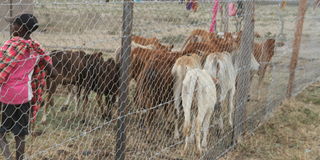Listen to indigenous people on conservation, NGO leader says

Calves in a predator-proof boma at Mr Mathew Ntayia’s home Nkoirienito home in Olderkesi, Narok West. An NGO leader has said indigenous and local communities should be given a chance to speak on their social, economic and conservation issues.
Indigenous and local communities should be given a chance to speak on their social, economic and conservation issues, the leader of a nongovernmental organisation has said.
World Wide Fund for Nature-Kenya CEO Mohammed Awer says conservation approaches designed in collaboration with communities and indigenous peoples can help mitigate any negative social impacts while providing lasting incentives – and benefits – for sustainable management of natural resources.
Mr Awer spoke in Olpusimoru on the Kenya-Tanzania border during the handing over of three 3,000-litre solar-powered milk cooling plants to three women’s groups from Olderkesi, Olkinyei and Lemek conservancies.
He urged leaders, NGOs and partners in the tourism sector to respect the rights of indigenous people and local communities.
Nature-based solutions
"Interventions like nature-based solutions add to the efforts of the local people like the Maasai community living along the Kenya-Tanzania border,” he said.
“Their legitimate voice must be heard. Leaders must amplify the voice of the Maasai and other indigenous communities. Organise forums for them to discuss how best to take this agenda forward.”
Following the outbreak of Covid-19, WWF-Kenya, he said, donors provided emergency grants of about 2.5 million euros to support locals in the larger Mara and Tsavo areas.
“This was under our BMZ-funded climate change adaptation project,” he said.
In the Olderkesi Conservancy, the community has also benefited from a 5,000 cubic metre water pan that will serve people and their livestock. Local youth groups received 100 beehives to start a beekeeping project.
Water pans
The Lemek and Olkinyei conservancies also benefited from two water pans to help mitigate human-wildlife conflict, with 24 predator-proof bomas for the communities to minimise such conflicts.
The transboundary initiative is ecologically connected and animals move within the targeted area. But it is not business as usual considering the unique circumstances of the region.
The population in the area has increased four-fold in the last 40 years and in the next 40 years will hit 100 million.
“We must put in place proactive measures to ensure that people have enough spaces by providing the right development initiatives but also ensure there are spaces left for wildlife,” Mr Awer said.
Monitoring equipment
The water reservoirs serve wildlife and livestock. Each of the three conservancies has also received two motorcycles and wildlife monitoring equipment, including six GPS devices, seven binoculars, 105 camera traps and computers.
Olderkesi Women’s Group chairperson Nayoi Lukeine said: "This project has given us a positive vision and will help women grow their own businesses."
Narok West MP Gabriel Tongoyo, who attended the launch, echoed the WWF-Kenya sentiments.
"The conservancy model is the way into the future due to climate change. Politics that pit communities against each other is unacceptable," he said.





